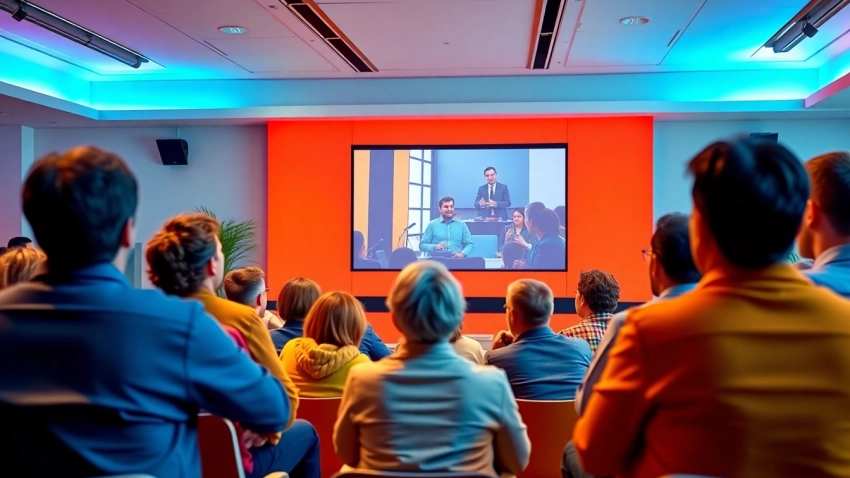
Enhance Engagement with a Virtual Audience System for Seamless Online Events
Understanding the Virtual Audience System
What is a Virtual Audience System?
A Virtual Audience System (VAS) is an innovative platform designed to facilitate live interactions between presenters and their audiences in an online environment. Unlike traditional video conferencing tools, VAS integrates specialized features that enhance engagement, enabling hosts to connect with participants more effectively. It typically encompasses tools for live polling, Q&A sessions, chat functionalities, and real-time feedback, transforming a standard viewing experience into a dynamic interaction. A well-implemented Virtual Audience System enhances the overall experience of virtual events, making them more enjoyable and memorable for attendees.
Key Features of Virtual Audience Systems
The strengths of a Virtual Audience System are reflected in its array of features, each designed to maximize audience engagement and interaction:
- Real-time Polling and Surveys: This feature allows presenters to gauge audience opinions and gather information instantly. Live polls increase participation and keep the audience actively involved.
- Q&A Sessions: Facilitating questions from attendees can maintain interest and provide clarity on discussed topics. These sessions can be managed live or through pre-submitted queries.
- Breakout Rooms: For more focused discussions or workshops, breakout rooms can enable smaller group interactions, fostering deeper engagement.
- Interactive Multimedia Content: Incorporating videos, animations, or live demonstrations can significantly enhance the learning experience for participants.
- Analytics and Reporting: A robust VAS tracks engagement metrics, providing insights into audience behavior, which can be invaluable for future event planning.
Benefits of Using a Virtual Audience System
Utilizing a Virtual Audience System brings numerous advantages to event organizers and participants alike:
- Increased Reach: Virtual systems enable reaching a global audience without the geographical constraints of physical events. Attendees from different regions can join seamlessly, enhancing diversity.
- Cost-Effective: Reducing travel and accommodation expenses while opting for a virtual platform results in significant savings for both organizers and participants.
- Enhanced Engagement: Features like polls, interactive content, and live Q&A keep attendees engaged, making the virtual experience more akin to in-person events.
- Flexibility: Virtual systems allow hosts to easily adjust content, respond to audience needs, and modify agendas on the fly, creating a responsive environment.
- Comprehensive Data Collection: Analyzing engagement and feedback helps refine future events and provides insights into audience preferences and behavior.
Setting Up Your Virtual Audience System
Essential Tools and Software
Setting up a Virtual Audience System requires careful selection of tools and software that cater to the needs of your event. Below are some essential components:
- Video Conferencing Software: Choose a platform that supports high-quality video and audio for seamless communication. Options like Zoom, Microsoft Teams, and Webex are popular choices.
- Audience Engagement Tools: Tools such as Slido, Mentimeter, or Poll Everywhere enhance interaction by facilitating live surveys and polls.
- Content Management Systems: A CMS can host your event content, resources, and schedules, ensuring attendees have easy access to all relevant materials.
- Analytics Software: Implement analytics tools to track attendee behavior and collect data that informs future endeavors. Google Analytics or built-in software analytics can be instrumental.
Step-by-Step Setup Guide
To successfully implement a Virtual Audience System, follow these step-by-step guidelines:
- Define Your Goals: Establish clear objectives for your event. Consider what you want to achieve with audience engagement, such as increased participation or feedback collection.
- Select the Right Tools: Based on your goals, choose software and tools that align with your needs, as discussed above.
- Plan the Event Agenda: Design a detailed agenda incorporating engaging elements, breaks, and interaction points to maintain audience attention.
- Test Your Setup: Conduct rehearsal sessions to ensure all software is functioning properly. Familiarize your team with the technology to minimize glitches during the live event.
- Deliver and Engage: During the event, actively interact with the audience through polls, chat, and Q&A, ensuring that attendees feel valued and engaged.
Customization Options for Your Audience Experience
The ability to customize your audience’s experience can significantly enhance engagement. Some key customization options include:
- Branding Elements: Incorporate your brand elements such as logos, colors, and themes to maintain consistency and reinforce brand identity throughout the event.
- Personalized Content: Tailor content to cater to different segments of your audience based on their interests or participation history, making the experience more relevant.
- Interactive Features: Customize the type of interactive features you incorporate—like gamification elements, challenges, or rewards to maintain interest.
- Communication Channels: Offer various channels (chat, video, forum) for participants to engage according to their comfort levels and preferences. This diversity can enhance participation.
Best Practices for Engaging Your Virtual Audience
Interactive Features to Enhance Participation
To enhance participation, it is crucial to integrate interactive features throughout your virtual event. Key strategies include:
- Live Polling: Introduce polls at strategic points to assess audience opinions and adapt content on the fly.
- Breakout Sessions: Utilize smaller group discussions to foster intimate conversations and encourage quieter members to share their thoughts.
- Gamification: Implement games or competitions that encourage participation and offer incentives or prizes to winners.
- Feedback Loops: Create opportunities for attendees to provide feedback in real-time, enhancing the interactive experience and showing that their input is valued.
Effective Communication Strategies
Clear and engaging communication is vital in retaining a virtual audience’s attention. Effective strategies include:
- Set Expectations: Clearly communicate the event structure, timings, and how attendees can participate beforehand.
- Engaging Openings: Start with a captivating introduction, perhaps through an engaging anecdote or video, to grasp the audience’s interest immediately.
- Active Listening: Acknowledge audience contributions during the event, demonstrating that their input is recognized and appreciated.
- Visual Aids: Utilize visually engaging slides or videos to illustrate points clearly. Engaging visuals can help maintain interest and clarify complex ideas.
Measuring Engagement and Feedback
To refine future events, it’s essential to measure engagement and feedback. Here are effective methods:
- Post-Event Surveys: Launch surveys immediately following the event to gather insights about attendees’ experiences and suggestions for improvement.
- Engagement Metrics: Use built-in analytics tools to track participation rates, chat interactions, and poll participation to quantify engagement levels.
- Follow-up Interviews: Conduct interviews with key participants to gain qualitative insights about their experiences and expectations for future events.
- Social Media Monitoring: Monitor social media channels for discussions related to your event, gaining insights on the broader perception of your audience.
Case Studies: Successful Use of Virtual Audience Systems
In-Person vs. Virtual: A Comparative Analysis
Comparing in-person events with virtual audience systems reveals distinct advantages of the latter:
- Cost-Efficiency: Virtual events often incur less overhead without the need for a physical venue, accommodations, or travel, making them financially viable.
- Attendance Rates: Virtual platforms have seen an uptick in attendance, breaking geographical barriers that often limit in-person participation.
- Scalability: Virtual events can scale up or down in attendance, allowing for adapting content based on the size of the audience.
- Content Accessibility: Recording and streamlining content for later accessibility is easier in a virtual environment, allowing participants to revisit discussions anytime.
Brands That Thrived with Virtual Audiences
Several brands have leveraged Virtual Audience Systems effectively:
- Salesforce: Their annual Dreamforce conference transitioned successfully to a virtual format, with thousands attending online. They utilized interactive sessions and live demos to maintain engagement.
- Adobe: Adobe Max shifted to a virtual platform, incorporating live workshops and breakout sessions, leading to their largest attendance ever, enabling more users to connect and engage.
- Google: Google I/O went online, providing a plethora of tools and interactive features that kept developers informed и engaged, while simultaneously broadening their audience base globally.
Lessons Learned from Virtual Event Failures
While many brands have succeeded, several have faced challenges in their virtual events:
- Poor Technology Setup: Some events struggled due to inadequate technology, leading to disruptions and disengagement from attendees. Proper testing and rehearsal can mitigate such issues.
- Ignoring Audience Needs: Failing to engage with the audience can lead to disinterest. Always solicit feedback and adapt based on participants’ preferences.
- Overcomplicated Structures: Some events went overboard with complex features that overwhelmed participants. Simplicity and clarity should guide the event structure.
- Inflexibility: Success hinges on adaptability. Events that couldn’t pivot based on real-time audience feedback faced criticism and lower engagement.
The Future of Virtual Audience Systems
Trends Shaping the Future of Online Engagement
The evolution of technology continues to shape how virtual audience systems will function in the future:
- Hybrid Events: The blend of virtual and in-person experiences is predicted to rise, allowing participants to choose formats based on their preferences.
- Increased Personalization: AI-driven analytics will allow for even greater personalization in content delivery, adapting sessions to real-time audience feedback.
- Blockchain Technology: Secure ticketing and digital engagement will likely be enhanced with blockchain solutions, fostering trust and security in transactions.
- Augmented and Virtual Reality: AR and VR technologies are expected to redefine events, providing immersive experiences that engage audiences like never before.
Innovative Technologies on the Horizon
Several emerging technologies promise to further elevate the virtual audience experience:
- 5G Connectivity: This advancement will facilitate uninterrupted streaming and enhance the quality of virtual experiences, particularly in mobile contexts.
- Artificial Intelligence: AI will likely automate many administrative tasks, providing personalized recommendations and insights to both organizers and attendees.
- Brain-Computer Interfaces: Though still in its infancy, the potential of direct neural interface technologies could revolutionize how audiences interact with content.
- Social Media Integration: Future systems may provide seamless integration with social platforms, allowing effortless content sharing and broader audience reach.
Predictions for Virtual Events in the Next Decade
Looking ahead, several predictions regarding virtual audience systems come to light:
- Wider Acceptance: As technology evolves and becomes more accessible, virtual events will be widely accepted as a standard format across industries.
- Inclusive Experiences: Expect more focus on making virtual events accessible to all, with features catering to individuals with disabilities and different learning styles.
- Enhanced Community Building: Future VAS will emphasize building long-term communities, fostering ongoing engagement beyond single events.
- Data Security and Privacy: As data breaches continue to be a concern, robust security measures will become a cornerstone of virtual event management.












Leave a Reply